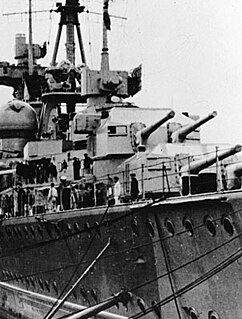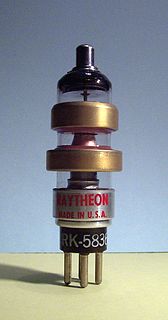
A cathode-ray tube (CRT) is a vacuum tube containing one or more electron guns, the beams of which are manipulated to display images on a phosphorescent screen. The images may represent electrical waveforms (oscilloscope), pictures, radar targets, or other phenomena. A CRT on a television set is commonly called a picture tube. CRTs have also been used as memory devices, in which case the screen is not intended to be visible to an observer.

The United States Navy Salmon-class submarines were an important developmental step in the design of the "fleet submarine" concept during the 1930s. An incremental improvement over the previous Porpoise class, they were the first US submarine class to achieve 21 knots with a reliable propulsion plant, allowing them to operate with the Standard-type battleships of the surface fleet. Also, their 11,000 nautical miles (20,000 km) unrefueled range would allow them to operate in Japanese home waters. These rugged and dependable boats provided yeoman service during World War II, along with their immediate successors, the similar Sargo class. In some references, the Salmons and Sargos are called the "New S Class", 1st and 2nd Groups.

Autofrettage is a metal cold forming technique in which a pressure vessel is subjected to enormous pressure, causing internal portions of the part to yield plastically, resulting in internal compressive residual stresses once the pressure is released. The goal of autofrettage is to increase the durability of the final product. Inducing residual compressive stresses into materials can also increase their resistance to stress corrosion cracking; that is, non-mechanically-assisted cracking that occurs when a material is placed in a corrosive environment in the presence of tensile stress. The technique is commonly used in manufacture of high-pressure pump cylinders, warship and tank gun barrels, and fuel injection systems for diesel engines. While autofrettage will induce some work hardening, that is not the primary mechanism of strengthening.

The Royal Ordnance L7, officially designated Gun, 105 mm, Tank, L7, is the basic model of the United Kingdom's most successful tank gun. The L7 is a 105 mm L/52 rifled design by the Royal Ordnance Factories intended for use in armoured fighting vehicles, replacing the earlier 20-pounder (84 mm) tank gun mounted on the Centurion tank. The successful L7 gun has been fitted on many armored vehicles including the British Centurion, the German Leopard 1 and early variants of the US M1 Abrams.

A mercury-vapor lamp is a gas-discharge lamp that uses an electric arc through vaporized mercury to produce light. The arc discharge is generally confined to a small fused quartz arc tube mounted within a larger borosilicate glass bulb. The outer bulb may be clear or coated with a phosphor; in either case, the outer bulb provides thermal insulation, protection from the ultraviolet radiation the light produces, and a convenient mounting for the fused quartz arc tube.

The T28 Super Heavy Tank was an American heavily armored tank/self-propelled gun designed for the United States Army during World War II. It was originally designed to break through German defenses of the Siegfried Line, and was later considered as a possible participant in the planned invasion of the Japanese mainland.
This article explains terms used for the British Armed Forces' ordnance and also ammunition. The terms may have slightly different meanings in the military of other countries.

Algérie was the last Treaty cruiser constructed for La Marine Nationale and possibly the best Treaty Cruiser from the technical standpoint by any of the naval powers. Designed and built in response to the Italian's Zara Class of 8 inch gunned cruisers, she was a totally new design and not based on the previous ships. The armoured caisson system used in Foch and Dupleix was abandoned in favour of a full armoured belt enclosing both the magazines and machinery spaces. She abandoned the unit propulsion system used previously and grouped her boilers forward leading to the reduction to a single funnel. She was one of the first vessels to utilize super heating boilers. Welding was used primarily in place of the normal rivetting in previous vessels. She maintained the same main armament but her secondary guns were increased to 100 mm guns. She served in the Mediterranean after entering service then searched for German surface raiders at the beginning of the war. She was at Toulon at the time of the Armistice and remained there until scuttled in November 1942.

The Normandie class consisted of five dreadnought battleships ordered for the French Navy in 1912–1913. It comprised Normandie, the lead ship, Flandre, Gascogne, Languedoc, and Béarn. The design incorporated a radical arrangement for the twelve 340 mm (13.4 in) main battery guns: three quadruple-gun turrets, the first of their kind, as opposed to the twin-gun turrets used by most other navies. The first four ships were also equipped with an unusual hybrid propulsion system that used both steam turbines and triple-expansion steam engines to increase fuel efficiency.

The Russian battleship Poltava was one of three Petropavlovsk-class pre-dreadnought battleships built for the Imperial Russian Navy in the 1890s. The ship was transferred to the Pacific Squadron shortly after completion and based at Port Arthur from 1901. During the Russo-Japanese War of 1904–1905, she participated in the Battle of Port Arthur and was heavily damaged during the Battle of the Yellow Sea. She was sunk by Japanese artillery during the subsequent siege of Port Arthur in December 1904, but was raised by the Imperial Japanese Navy (IJN) after the war and renamed Tango (丹後).

Outer Brewster Island, also known as Outward Island, is one of the outer islands in the Boston Harbor Islands National Recreation Area and is situated some 10 miles offshore of downtown Boston. The island has a permanent size of 20 acres, and consists of exposed bedrock covered by fertile soil bounded by a rocky shore with steep cliffs. It provides a nesting habitat for coastal water birds, including cormorants, gulls, common eider ducks, glossy ibis and American oystercatchers. The birds are aggressive during their nesting season and access by humans, which is by private boat only, is discouraged during this period.
During World War II, Nazi Germany's Kriegsmarine considered various submarine designs for specialized operations or improving U-boat performance. Many of these designs did not come to fruition for various reasons. Some were abandoned due to practical considerations. Others towards the end had to be abandoned, as the yards were overrun by allied forces.

The Kaiser Friedrich III class consisted of five pre-dreadnought battleships of the German Kaiserliche Marine ; all ships of the class were named for German emperors. The ships were Kaiser Friedrich III, Kaiser Wilhelm II, Kaiser Wilhelm der Grosse, Kaiser Barbarossa, and Kaiser Karl der Grosse, all built between 1895 and 1901. The class saw the introduction of the traditional armament layout for German battleships prior to the advent of the dreadnought type of battleship in the early 1900s: four large-caliber guns, but of comparatively smaller size compared to their contemporaries, in two gun turrets. The German adoption of smaller guns was a result of a preference for higher volumes of fire over weight of shell. The Kaiser Friedrich IIIs also standardized the use of three screws for battleships and introduced water-tube boilers and Krupp cemented armor.

The BL 12-inch Mark VIII naval gun was one of the first large British rifled breech-loading naval guns designed for the higher pressures generated by the new cordite propellant of the 1890s, and Britain's first large wire-wound gun. It represented a major advance compared to previous British guns.

The Polikarpov NB was a Soviet twin-engined bomber designed during World War II. Only a single prototype had been built before the program was terminated upon the death of Nikolai Nikolaevich Polikarpov, the head of the aircraft's design bureau, in 1944.

A built-up gun is artillery with a specially reinforced barrel. An inner tube of metal stretches within its elastic limit under the pressure of confined powder gases to transmit stress to outer cylinders that are under tension. Concentric metal cylinders or wire windings are assembled to minimize the weight required to resist the pressure of powder gases pushing a projectile out of the barrel. Built-up construction was the norm for guns mounted aboard 20th century Dreadnoughts and contemporary railway guns, coastal artillery, and siege guns through World War II.

The 20.3 cm SK C/34 was the main battery gun used on the German Admiral Hipper-class heavy cruisers.
The AT4 is an 84-mm unguided, portable, single-shot recoilless smoothbore anti-tank weapon built in Sweden by Saab Bofors Dynamics. Saab has had considerable sales success with the AT4, making it one of the most common light anti-tank weapons in the world.

A Sutton tube, or reflex klystron, is a type of vacuum tube used to generate microwaves. It is a low-power device used primarily for two purposes; one is to provide a tuneable low-power frequency source for the local oscillators in receiver circuits, and the other, with minor modifications, as a switch that could turn on and off another microwave source. The second use, sometimes known as a soft Sutton tube or rhumbatron switch, was a key component in the development of microwave radar by Britain during World War II. Microwave switches of all designs, including these, are more generally known as T/R tubes or T/R cells.

The 8"/35 caliber gun Mark 3 and Mark 4 were used for the main batteries of the United States Navy's first armored cruisers and the secondary batteries for their first battleships, the Indiana-class. The 8"/40 caliber gun Mark 5 initially armed the Pennsylvania-class armored cruisers.
















